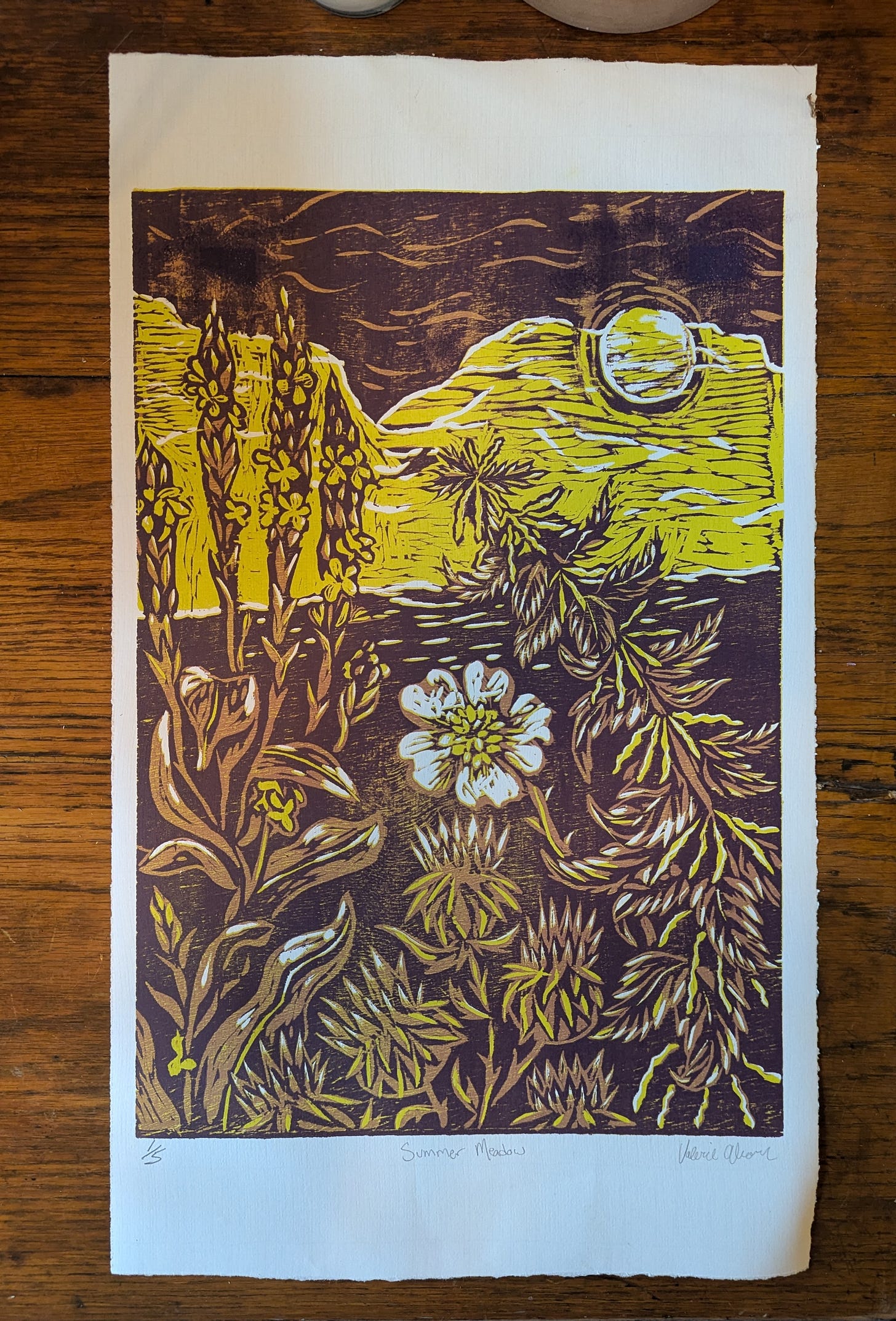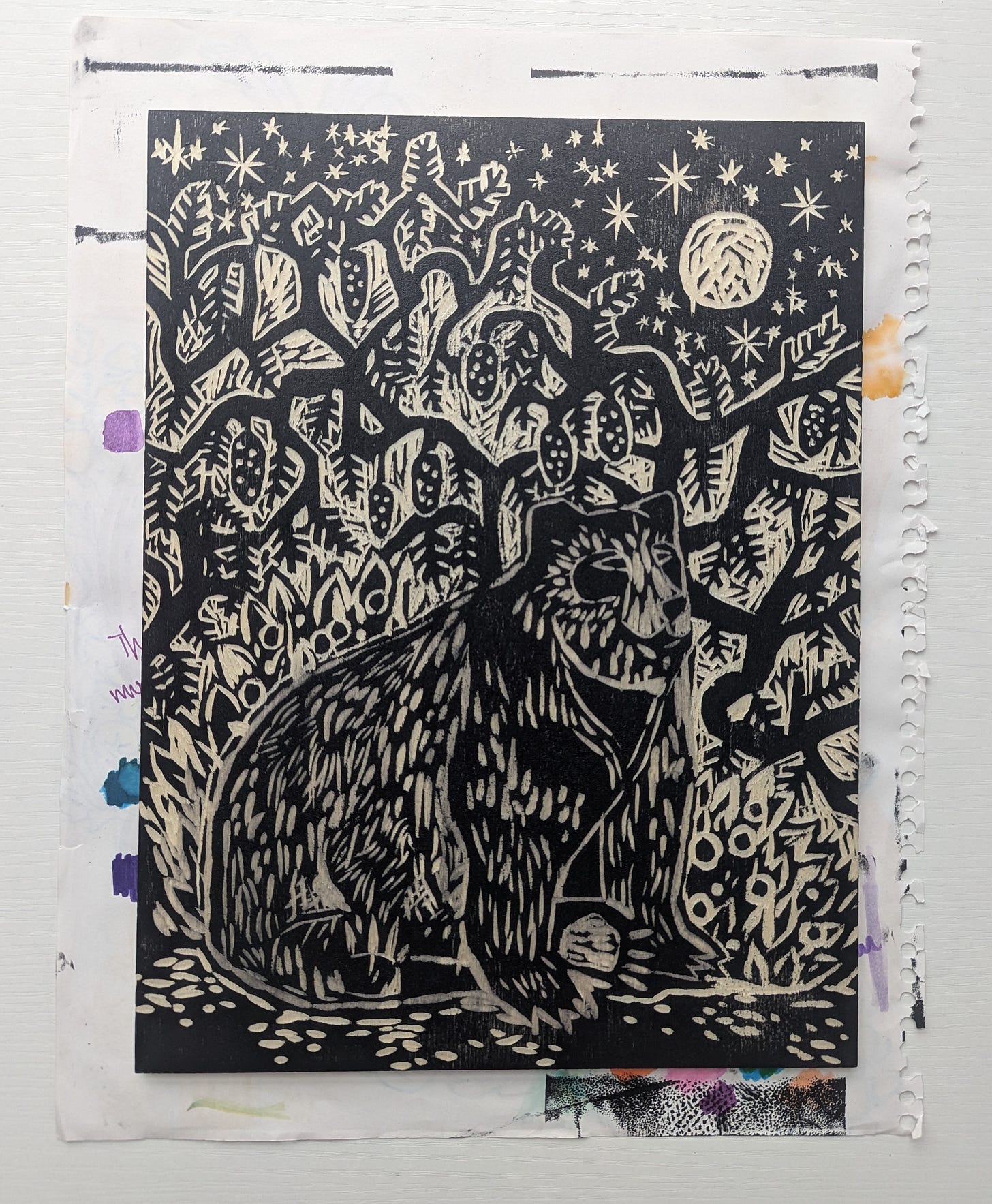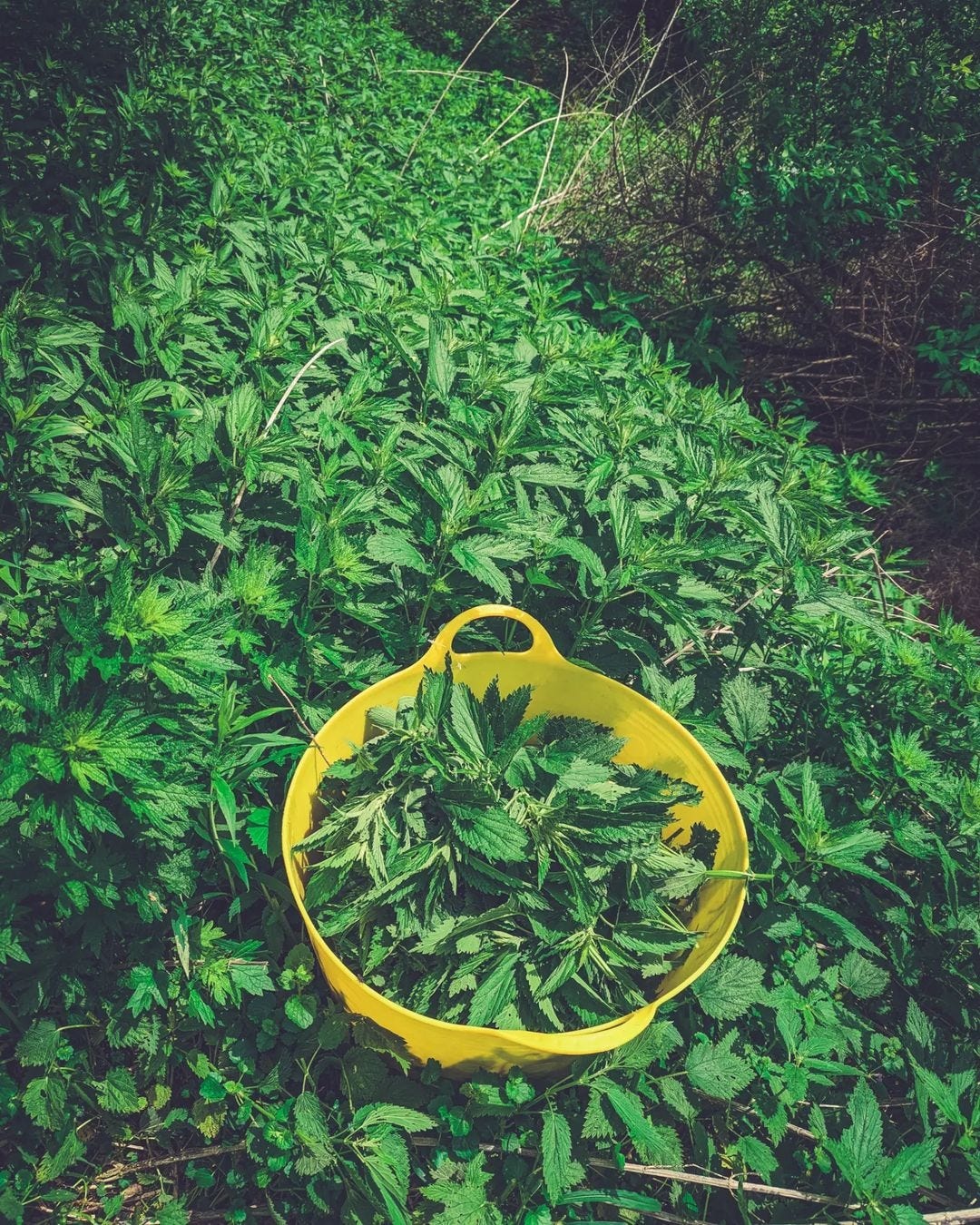2024 has been a year of loss. I’ve shed countless things, shattered completely, my world has shrunk exponentially. But the loss has been my greatest creation. I’ve crafted its disintegration with meticulous intention. It’s beautiful here.
Here are just a few thoughts on things that have stayed and some lessons that were gained, most involving the plants who have walked with me.
From the studio
Being able to dive deeper into my art practice this year was such a balm. I fell in love with printmaking, specifically woodcuts. There is something special about working with wood as a medium.
When you use paper you’ve lost all identity of the tree it came from. But with woodcuts, you see a hint of its spirit there. Cherry is hard, wonderful for fine details. Linden is beloved among Japanese printmakers for its character. Birch and pine are soft and pliable, letting the wood carve loosely and freely. Any tree can be carved, each with its own voice.
Then every individual piece of wood is unique. You get to see the grain of the tree, let it shape your lines and the story you’re trying to tell. You give up some control to the tree. There may be a plan, but the grain dictates the carving in the end. It is a rough medium that requires you to surrender, to enter into a collaboration with the tree you’re shaping. It asks you to create with a loose grip and room for a change of direction.
It has been a great teacher for me as I often find myself getting too lost in the detail. I want to create more symbolically, to infuse a piece with life and movement rather than precision. This has encouraged me to let go of perfection and embrace feeling.
It is the oldest form of printing. Each copy is an original as ink is lovingly mixed, rolled onto the block, pressed and printed. While it does encourage a loose hand, it is also a technical process that requires you to recreate a print perfectly again and again. It challenges the ability to sketch, to mix color, carve, print, to see the bigger picture beneath the grain.

From the apothecary
I used to wonder how people could pick nettle without gloves. The stinging hairs can be a lingering shock to the unsuspecting hand. Maybe the plants had an agreement with them that I couldn’t understand. Maybe there was a secret technique to harvesting I had never learned.
It took me awhile to realize that no one who works with nettle avoids their sting completely. There are tricky ways to harvest to minimize the sting like plucking the young leaves from the top or pinching the stem with your thumb and forefinger, but the sting is almost inevitable even to the experienced forager.
So why not just use gloves then?
Wearing gloves would be like having a one-sided conversation where I do all the speaking without listening.
~ Megan Leach
Those who choose to harvest nettle without gloves view the sting as an opportunity to pause, listen, maybe approach the stem at another angle. They accept the pain instead of avoiding it.
Life is like this.
We are programmed to avoid pain at all costs. We’ve built modern society to make our lives as convenient and pain free as possible. And all that seems to have brought us is more pain and more fear. What I learned this year is that it actually hurts less when you let pain in.
Like using gloves to harvest nettle, when we avoid discomfort, numb the intensity of our feelings, run from what is raw and real, are we only having a one-sided conversation with life?
In fact, there is a lesson about pain in nettle’s medicine too. It is folk practice to whip achy rheumatic joints with fresh nettle plants to relieve pain. When the spiky hairs enter your skin, they release several chemicals including serotonin and histamine. Essentially, nettle reduces pain by stimulating pain neurons. The skin irritation ends up overriding musculoskeletal pain. In the end, the pain is the medicine.
So how do we approach pain when every bit of common sense is telling us to escape no matter the consequence?
It’s all about tension.
A cat falls from a tree and lands on its feet not because it has nine lives, but because it lets itself go. Once the cat reaches terminal velocity, it relaxes completely. The cat’s fall actually slows from this point onward because this flexibility allows them to get into a more agreeable position for landing. It then lands lightly on the ground as if it didn’t just fall from a second story building.
Apply this to any situation where your first reaction is to tense up.
During labor Asher finally arrived when I relaxed my pelvis. It didn’t matter how hard I pushed. It was only this act of letting go that made way for his very large head.
Of course it seems counterintuitive and nearly impossible to relax during times of such intensity, but that’s our greatest challenge in life isn’t it? Do we have what it takes to relax instead of resist, embody peace within war, find joy in the pain, let go when all you want to do is hold on tighter?
When life favors the extremes, we must act as the loadstone on the other end of the scale to balance the weight.
Nettle says it’s ok if it hurts. It’s ok if it’s hard. It doesn’t mean you’re doing it wrong. It means you’re real. You’re alive. You’re listening. You’re growing.
Some more lessons from the land
Let the more-than-human world hold you.
Look for signs in the flowers and the birds.
Drink marshmallow root tea when you need softness.
Take a blue vervain tincture when you need a break from your own intensity.
Infuse heaps of raspberry leaf, nettle and burdock to replenish the body.
Grow roses in honor of all the grandmothers who came before you.
Sip a cup of chamomile when you need to be held like a child.
Eat a wild apple to remind you what freedom from domestication tastes like.
Observe the tattered mullein leaf, now look closer and see how it sustains dozens of little buzzing lives.
Commune with cacao when you crave sugar.
Harvest and dry cornflowers to add color and joy to your tea blends.
Sit with an old pine when you need to quiet your mind.
May these final moments of the year bring you gentle reflection and intention for a new beginning.
Much love,
Val
P.S. Feel free to share, it’s much appreciated!
If you want to move deeper into a seasonal land-based life, consider ordering my 2025 Lunar + Seasonal Planner. Because learning to live in tune with the land doesn’t come from grand gestures or life-altering shifts, but rather from daily routines, devotions and observations of the land and how we relate to it.
This yearly planner weaves seasonal land-based practices with modern living so that you can live more intentionally and presently within every season of your life. It was created for the plant people, the land lovers, the gardeners, and the seekers to plan their lives around the rhythms of the earth as our ancestors have for thousands of years. More than just a planner, it is a practical yet spiritual guide to living, working, gardening, and celebrating in tune with the ever-shifting world around us.
Become a free subscriber for weekly musings from the forest. To receive seasonal guides and explorations, consider becoming a paid subscriber.








This is so very beautiful, friend. And I love seeing your prints!!
Oh my gosh 💛 sending you the deepest gratitude for this writing. I read it sitting on my porch listening to the chickadees and looking at the peeling bark of the paper birch and…man for the first time in a long time I felt connected again. Thank you.